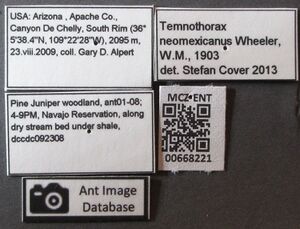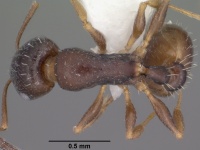Temnothorax neomexicanus
| Temnothorax neomexicanus | |
|---|---|

| |
| Scientific classification | |
| Kingdom: | Animalia |
| Phylum: | Arthropoda |
| Class: | Insecta |
| Order: | Hymenoptera |
| Family: | Formicidae |
| Subfamily: | Myrmicinae |
| Tribe: | Crematogastrini |
| Genus: | Temnothorax |
| Species group: | sallei |
| Species: | T. neomexicanus |
| Binomial name | |
| Temnothorax neomexicanus (Wheeler, W.M., 1903) | |
Summarized from Mackay (2000): Nests in open, dry grassy areas, in Ponderosa Pine forests or even in desert areas under rocks or in soil. Nests are monogynous and are marked by a hole in the ground and occasionally with a light, asymmetrical scattering of fine soil. Colonies are "rather small" (Cole. 1954)."
Identification
Prebus (2017) - A member of the sallei clade.
Mackay (2000) - Workers of this species have a 12-segmented antenna. the medial clypeal carina is well developed; the lateral carinae may be somewhat weakly developed. The anterior edge of the medial clypeal lobe is usually somewhat delineated by 1 or more transverse carinae. The head is covered with fine striolae, except for a central strip, which is partially smooth and shining. The node of the petiole is rounded or weakly truncate. The postpetiole is broad as seen from above (more than 1.5times the width of the postpetiole), but much less than 1/2 the width of the gaster. The propodeal spines are short and dentiform. The side of the mesosoma, petiole and postpetiole are more or less uniformly covered with a granulate or punctulate sculpture, which is so delicate that much of these areas, especially the mesosoma, are shining under various lighting conditions. The top of the mesosoma is covered with fine rugulae, which nearly form foveolate punctures. The subpeduncular process is poorly developed. consisting of a tiny bump.
The lateral carinae of the clypeus of both Temnothorax neomexicanus and Temnothorax nevadensis are very similar, in that they curve medially at the anterior part of the medial lobe of the clypeus, and connect. They can be easily separated as the head of Temnothorax neomexicanus is at least partly smooth and shining, whereas the dorsum of the head of Temnothorax nevadensis is nearly completely sculptured. It can be separated from Temnothorax carinatus in being much darker in color (Temnothorax carinatus is pale brown or brown-orange). The propodeal spines are well developed, but short (l/3 to 1/2 length of distance between bases), whereas the propodeal armature of Temnothorax carinatus consists of poorly developed angles.
Keys including this Species
- Key to Temnothorax andrei species group workers
- Key to Temnothorax of California
- Key to Temnothorax tricarinatus species group workers
- Key to the New World Temnothorax
Distribution
USA: Nevada, Utah, Colorado, Arizona, New Mexico, Texas. MEXICO: Chihuahua.
Latitudinal Distribution Pattern
Latitudinal Range: 40.249° to 19.14115°.
| North Temperate |
North Subtropical |
Tropical | South Subtropical |
South Temperate |
- Source: AntMaps
Distribution based on Regional Taxon Lists
Nearctic Region: United States (type locality).
Neotropical Region: Mexico.
Distribution based on AntMaps
Distribution based on AntWeb specimens
Check data from AntWeb
Countries Occupied
| Number of countries occupied by this species based on AntWiki Regional Taxon Lists. In general, fewer countries occupied indicates a narrower range, while more countries indicates a more widespread species. |

|
Estimated Abundance
| Relative abundance based on number of AntMaps records per species (this species within the purple bar). Fewer records (to the left) indicates a less abundant/encountered species while more records (to the right) indicates more abundant/encountered species. |

|
Habitat
Open, dry grassy areas; from desert through Ponderosa Pine forests.
Abundance
Common to abundant in some areas.
Biology
Foraging/Diet
An insinuater species (Lebrun 2005)
Regional Notes
New Mexico
Cole (1953): Collections of Temnothorax neomexicanus were taken in Cimarron Canyon, between Cimarron and Ute Park, at elevations of 6,500 and 6,700 feet. The nests were in moist soil beneath stones in open, grassy areas.
Mackay and Mackay (2002) - This species nests in the soil, or under stones, in open areas. Nests are monogynous and are marked by a hole in the ground, occasionally with a light, asymmetrical scattering of fine soil. Colonies are small.
Life History Traits
- Queen number: monogynous (Frumhoff & Ward, 1992)
Castes
Lebrun (2005) - Average worker dry weight: 0.11 +- 0.003 (mg)
Worker
   
| |
| . | Owned by Museum of Comparative Zoology. |
Images from AntWeb
   
| |
| Worker. Specimen code casent0010695. Photographer April Nobile, uploaded by California Academy of Sciences. | Owned by UCDC, Davis, CA, USA. |
Queen
   
| |
| . | Owned by Museum of Comparative Zoology. |
Nomenclature
The following information is derived from Barry Bolton's Online Catalogue of the Ants of the World.
- neomexicanus. Leptothorax neomexicanus Wheeler, W.M. 1903c: 248, pl. 12, fig. 18 (w.) U.S.A. Combination in Temnothorax: Bolton, 2003: 271. Subspecies of tricarinatus: Creighton, 1950a: 273; Smith, M.R. 1952b: 100. Revived status as species: Mackay, 2000: 374.
Unless otherwise noted the text for the remainder of this section is reported from the publication that includes the original description.
Description
Worker
Length 2.25-2.5 mm. Head longer than broad. Mandibles 5-toothed. Clypeus moderately convex, broadly rounded in front, not impressed. Antennae slender, 12-jointed; scape extending to a distance equal to its own breadth beyond the posterior angle of the head; funiculus terminating in a 3-jointed club, the two basal joints of which are subequal and together shorter than the terminal joint; first funicular joint as long as the tliree succeeding joints together; joints 2-8 of the funiculus as long as broad. Thorax not much broader in front and above than behind and below; humeral angles rounded; dorsal surface flattened, without mesoepinotal suture or constriction. Epinotal spines short, robust, blunt, not longer than broad at their bases and nearly twice as far apart at their bases as long. They are directed obliquely upward, outward and backward. Petiole hardly 1 1/2 times as long as broad; distinctly wider behind than in front, sides somewhat convex; in profile the node is nearly as high as the length of the petiole, its anterior slope steep, slightly concave; the summit somewhat truncated, passing abruptly into the angular posterior declivity; ventral surface in front with a prominent tooth, directed downward and forward. Postpetiole nearly twice as broad as the petiole; nearly as long as broad, subglobular, its anterior dorsal surface in profile abruptly convex, the posterior dorsal surface more flattened. Gaster of the usual shape with slight basal angles.
Mandibles coarsely striated and punctate. Clypeus longitudinally rugose, especially on the sides, behind without rugae, smooth and shining, somewhat foveolate-punctate. Head subopaque except along a broad median strip, extending from the frontal area to the occiput, and on the posterior angles. These regions are smooth and shining. Cheeks and sides of head rather delicately and longitudinally reticulate-rugose. On the front and vertex there are also a few rather large indentations at widely separated intervals. Thorax nearly opaque, in front delicately and evenly reticulate-rugose; on the epinotum and pleurre the rugae are coarser and have a distinctly longitudinal trend. Petiole and postpetiole nearly opaque, finely reticulate-rugose. Gaster very smooth and shining.
Hairs rather sparse, silvery-white; those on the body subclavate, shorter and more erect on the head and thorax, longer and more reclinate on the pedicel and gaster. Hairs on the legs and antennae short, non-clavate, appressed.
Black. In some specimens the pedicel and thorax are dark-brown. Scape and funiculus of antennae brown. Mandibles yellow, with black teeth. Legs yellow, middle portion of the femora and tibiae and terminal tarsal joint on each foot, black.
Type Material
Mackay (2000) - USA: New Mexico, Manzanares American Museum of Natural History, Museum of Comparative Zoology [seen].
Etymology
Toponym. Referring to the New Mexico origin of the type collection.
References
- Mackay, W. P. and E. Mackay. 2002. The ants of New Mexico (Hymenoptera: Formicidae). Edwin Mellen Press, Lewiston, NY.*Alatorre-Bracamontes, C.E., Vásquez-Bolaños, M. 2010. Lista comentada de las hormigas (Hymenoptera: Formicidae) del norte de México. Dugesiana 17(1): 9-36.
- Bolton, B. 2003. Synopsis and Classification of Formicidae. Mem. Am. Entomol. Inst. 71: 370pp (page 271, Combination in Temnothorax)
- Cole, A. C., Jr. 1953. Notes on the genus Leptothorax in New Mexico and a description of a new species. Proceedings of the Entomological Society of Washington. 55:27-30.
- Cole, A. C., Jr. 1954. Studies of New Mexico ants. X. The genus Leptothorax (Hymenoptera: Formicidae). Journal of the Tennessee Academy of Science. 29:240-241.
- Creighton, W. S. 1950a. The ants of North America. Bulletin of the Museum of Comparative Zoology 104: 1-585 (page 273, Subspecies of tricarinatus)
- LeBrun, E. G. 2005. Who is the top dog in ant communities? Resources, parasitoids, and multiple competitive hierarchies. Oecologia (Berlin). 142:643-652.
- MacKay, W. P. 2000. A review of the New World ants of the subgenus Myrafant, (genus Leptothorax) (Hymenoptera: Formicidae). Sociobiology 36: 265-444 (page 374, Revived status as species)
- Prebus, M. 2017. Insights into the evolution, biogeography and natural history of the acorn ants, genus Temnothorax Mayr (hymenoptera: Formicidae). Bmc Evolutionary Biology. 17:250. doi:10.1186/s12862-017-1095-8 (The doi link to the publication's journal webpage provides access to the 24 files that accompany this article).
- Prebus, M.M. 2021. Taxonomic revision of the Temnothorax salvini clade (Hymenoptera: Formicidae), with a key to the clades of New World Temnothorax. PeerJ 9, e11514 (doi:10.7717/peerj.11514).
- Smith, M. R. 1952. North American Leptothorax of the tricarinatus-texanus complex (Hymenoptera: Formicidae). Journal of the New York Entomological Society. 60:96-106.
- Smith, M. R. 1952c. North American Leptothorax of the tricarinatus-texanus complex (Hymenoptera: Formicidae). J. N. Y. Entomol. Soc. 60: 96-106 (page 100, Subspecies of tricarinatus)
- Snelling, R. R.; Borowiec, M. L.; Prebus, M. M. 2014. Studies on California ants: a review of the genus Temnothorax (Hymenoptera, Formicidae). ZooKeys 372:27-89. doi:10.3897/zookeys.372.6039
- Van Pelt, A. F. 1983. Ants of the Chisos Mountains, Texas (Hymenoptera: Formicidae). Southwestern Naturalist. 28:137-142.
- Wheeler, W. M. 1903. A revision of the North American ants of the genus Leptothorax Mayr. Proceedings of the Academy of Natural Sciences of Philadelphia. 55:215-260.
- Wheeler, W. M. 1906. The ants of the Grand Cañon. Bulletin of the American Museum of Natural History. 22:329-345.
References based on Global Ant Biodiversity Informatics
- Cover S. P., and R. A. Johnson. 20011. Checklist of Arizona Ants. Downloaded on January 7th at http://www.asu.edu/clas/sirgtools/AZants-2011%20updatev2.pdf
- Dattilo W. et al. 2019. MEXICO ANTS: incidence and abundance along the Nearctic-Neotropical interface. Ecology https://doi.org/10.1002/ecy.2944
- Des Lauriers J., and D. Ikeda. 2017. The ants (Hymenoptera: Formicidae) of the San Gabriel Mountains of Southern California, USA with an annotated list. In: Reynolds R. E. (Ed.) Desert Studies Symposium. California State University Desert Studies Consortium, 342 pp. Pages 264-277.
- Fernandes, P.R. XXXX. Los hormigas del suelo en Mexico: Diversidad, distribucion e importancia (Hymenoptera: Formicidae).
- Johnson R. Personnal Database. Accessed on February 5th 2014 at http://www.asu.edu/clas/sirgtools/resources.htm
- LaBrun, E.G. and D.H. Feener Jr. 2007. When trade-offs interact: balance of terror enforces dominance discovery trade-off in a local ant assemblage. Journal of Animal Ecology 76:58-64
- LeBrun, E.G. 2005. Who Is the Top Dog in Ant Communities? Resources, Parasitoids, and Multiple Competitive Hierarchies. Oecologia 142(4):643-652
- Mackay W. P. 2000. A review of the New World ants of the subgenus Myrafant, (genus Leptothorax) (Hymenoptera: Formicidae). Sociobiology 36: 265-444.
- Mackay W. P., and E. E. Mackay. 2002. The ants of New Mexico (Hymenoptera: Formicidae). Lewiston, New York: Edwin Mellen Press, 400 pp.
- O'Keefe S. T., J. L. Cook, T. Dudek, D. F. Wunneburger, M. D. Guzman, R. N. Coulson, and S. B. Vinson. 2000. The Distribution of Texas Ants. The Southwestern Entomologist 22: 1-92.
- Smith M. R. 1952. North American Leptothorax of the tricarinatus-texanus complex (Hymenoptera: Formicidae). Journal of the New York Entomological Society 60: 96-106.
- Van Pelt, A. 1983. Ants of the Chisos Mountains, Texas (Hymenoptera: Formicidae) . Southwestern Naturalist 28:137-142.
- Vásquez-Bolaños M. 2011. Lista de especies de hormigas (Hymenoptera: Formicidae) para México. Dugesiana 18: 95-133

